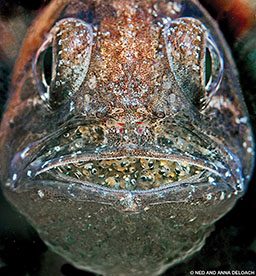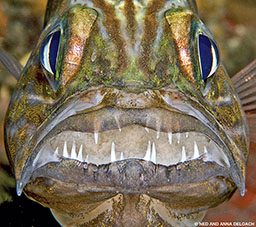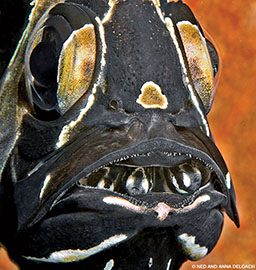Kneeling on the weedy bottom of Lembeh Strait, our Indonesian dive guide, Man, gestures me over in the tender manner of someone showing off a sleeping child. With a pointing stick he carefully lifts a skirt of algae to expose a rusty-brown cardinalfish the size of a peanut shell. “This certainly isn’t a fish to get someone excited,” I think as I turn toward Man and shrug. Man points to his jaw. I look again. Sure enough, the jaws of the unfashionable little fish bulge with a mouthful of recently laid orange eggs.
Nothing is more coveted on a reef than a dinner of plump, nutritious eggs, so protecting nests is hard work. To bypass this problem, most reef fishes spawn buoyant, millimeter-sized eggs by the thousands high above the reef. This hedge against hungry predators is the only parental assistance the offspring receive before being swept away with the currents on one of the most perilous odysseys in the animal kingdom. Within 24 hours the embryos hatch into defenseless yolk-sac larvae that are barely able to swim in an oceanic world that seems every bit as dangerous as the reef.

In contrast, many small reef fishes, such as gobies, blennies and damselfishes, tend and guard nests. Their efforts help allow offspring to safely pass through the perilous yolk-sac stage inside the safety of egg capsules before they join the great pelagic voyage. Male cardinalfishes take their duties even more to heart by brooding their eggs inside their mouths. Both strategies produce hatchlings better prepared to fend for themselves during their multiweek metamorphosis in the open sea. But even with extended nurturing, only a scattering of the progeny will ever make it back to home waters or, as is often the case, navigate the currents to reefs miles away where they settle and begin adult lives.
Seeing an opportunity, Anna, Man and I hatch a plan to revisit the weedy cardinalfish, Foa fo, over the next several days to document the transformation of his incubating eggs. The following afternoon, visibility at the dive site has dropped considerably, but it doesn’t mater to Man. As if following road signs, he leads us through the haze on a lengthy swim that takes us over a featureless terrain of rock rubble pocked with patches of algae and sponge and right back to fo. Man peels back the vegetation, and sure enough fo is where we left him, but this time he turns away and buries his head in his algal home.

Brooding males are easily unsettled and if distressed will bolt or, even worse, spit out their eggs, which would be horrifying. So we wait some distance away. Ten minutes pass before the father-to-be offers us a clear look at his swollen, jack-o’-lantern-orange jaws. We don’t detect any change in the clutch from the day before, but by the next morning the transformation has begun. The orange is gone, leaving behind a yellowish-gray sheen. Day four brings the eyes, which first appear as dots inside the translucent capsules. On our fifth visit, large steely gray eyes by the thousands stare back at us, and a curl of vertebrae can be seen inside each swollen orb. The following morning, day six, the clutch is gone, released during the night. The dispersing larvae more than likely hitched rides on an outgoing tide that carried them through the mouth of the strait and into the sea.
Like people who have lost a beloved pet, we miss fo and his brood and immediately set about searching for a replacement. During the afternoon dive Man locates a tiger cardinalfish lurking inside a crevice on a coral slope. Unlike our cherubic little fo, this is a massive 4-inch brute with a fresh clutch of white eggs securely corralled behind a picket fence of teeth.

On a roll, Man calls guides up and down the strait to see if anyone knows the whereabouts of an egg-laden Banggai cardinalfish — a superstar among mouthbrooders. The males of this lovely, discus-shaped species not only brood 40 or so oversized eggs inside their mouths but also retain hatchlings within their jaws for 10 additional days. As might be expected, the adaptation, which arose to eliminate the dangerous pelagic larval stage altogether, severely limits the species’ distribution. Until recently the species had been restricted to its historic home, the small set of Banggai Islands about 200 miles south of Lembeh. Seventeen years ago, however, a fish collector unscrupulously introduced the highly prized aquarium exotic to the strait.
A tip left on Man’s phone leads us to a 2-inch male Banggai with swollen jaws, hovering among a cluster of companions next to the wreckage of an old motor launch. Watching carefully, we occasionally catch a glimpse of tiny black-and-white faces — miniature versions of their parents — peeking out from the safety of their father’s mouth.
| © Alert Diver — Q2 2017 |